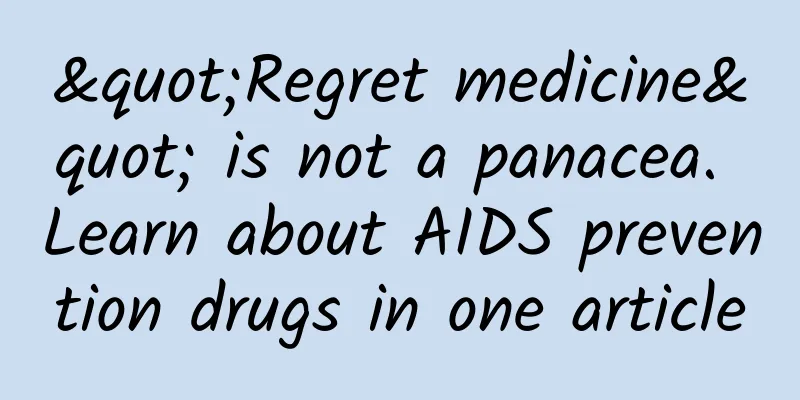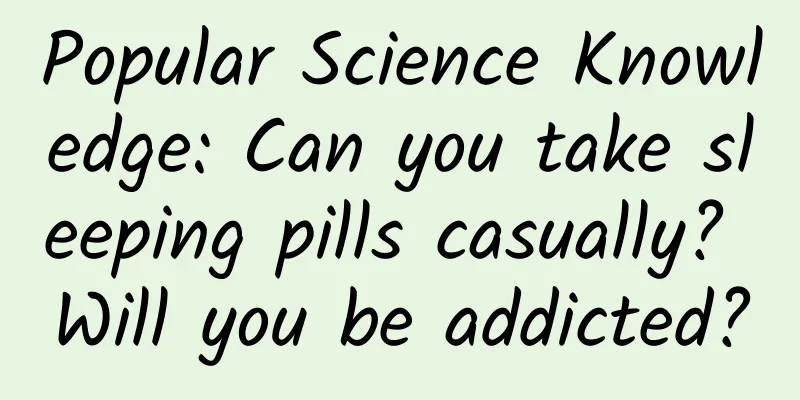"Regret medicine" is not a panacea. Learn about AIDS prevention drugs in one article

|
December 1, 2023 is the 36th "World AIDS Day". This year, my country's publicity theme is "Uniting social forces to fight AIDS together." We often say that "there is no regret medicine in the world", but people who work in AIDS prevention may know that there is a "regret medicine" for AIDS, and this "regret medicine" is HIV post-exposure prophylaxis (Post-exposure Prophylaxis, hereinafter referred to as PEP). Image source: pixabay The origins of HIV post-exposure prophylaxis I believe that every medical worker has heard of the following scenarios to some extent, or at least worried about them, or even experienced them: A nurse was performing deep vein puncture on a lymphoma patient. After removing the needle, she felt a sharp pain in her finger. Oops, she was pricked by the needle! Then she found blood seeping out from under her gloves. The lymphoma patient was also HIV positive... When a surgeon was removing a huge liver tumor from an HIV-positive patient, his assistant’s glove was accidentally scratched because he pulled back the knife too quickly. Although the surgeon treated the patient immediately, a slight scratch was still found on the skin. An emergency doctor received an emergency patient with a broken finger. All five fingers of the patient were severed, with the bones exposed. If the operation was delayed, the patient would die. Therefore, they organized emergency surgery to perform the operation immediately. Just as he was helping the patient to connect the third broken finger, an urgent report came from the laboratory that the patient tested positive for HIV. Although the operation was strictly carried out in accordance with aseptic procedures, anxiety and fear came physiologically... I believe that these scenes are not unfamiliar to many medical staff. In my country, there are an average of about 700 to 1,000 occupational exposure incidents each year, mainly in medical and health institutions, and a few in scientific research and public security systems, so these scalp-numbing situations are not uncommon. It is not uncommon for medical staff to be accidentally exposed to HIV in their work scenes, so how can they be protected? HIV post-exposure prophylaxis came into being, and the history of this therapy can be traced back to the late 1980s. Initially, this therapy was designed for healthcare workers to reduce the risk of infection after accidental exposure to HIV, and now it has benefited ordinary people. So how effective is this therapy? In my country, occupational post-exposure prevention has been carried out for more than 20 years, and thousands of cases have been implemented. So far, there has been no case of failure in prevention, which shows that PEP has a good preventive effect. Image source: pixabay What exactly is this magical “regret medicine”? HIV post-exposure prophylaxis refers to a method in which people who have not yet been infected with HIV take specific antiviral drugs as early as possible (no more than 72 hours) to reduce the risk of HIV infection after being exposed to a high risk of infection, such as exchanging body fluids with an HIV-infected person or a person with unknown infection status. Here are a few important points of information: 1. This regret medicine cannot cure those who are already infected, it can only protect those who are not infected; 2. Having sex with someone infected with HIV or whose infection status is unknown is also protected; 3. Must be taken within 72 hours (best to take within 2 hours after exposure). What exactly is this "regret medicine"? It is not as simple as a pill. PEP medication uses three antiviral drugs in combination. The commonly used PEP regimens in China include: (TDF or TAF, choose one) + (FTC or 3TC, choose one) + (DTG or RAL, choose one). Tenofovir and emtricitabine (or lamivudine) can also be replaced by emtricitabine tenofovir tablets or lamivudine tenofovir tablets two-in-one tablets. It should be noted that some people may experience side effects, such as headaches, insomnia, dizziness, fatigue, nausea, vomiting, or flatulence. Most of these symptoms will resolve on their own. However, some people find it difficult to stick to the full 28 days. However, patients who receive the treatment must strictly follow the requirements to take the medicine for 28 consecutive days. If the medication is interrupted, it is very easy to develop viral resistance and lead to blocking failure. However, we still need to remind everyone that although it is not 100% guaranteed to be successful, if you are unfortunately in high-risk contact with an AIDS patient, PEP is a glimmer of hope. Through this method, there is a chance to avoid infection and lifelong medication. Outrun the virus, race against time Why do we repeatedly emphasize taking the medicine within 72 hours? This is mainly related to the way the virus invades the human body. Image source: pixabay After the virus enters the subcutaneous tissue or mucous membrane, it is first recognized by dendritic cells, infects nearby CD4 cells, and then transmits to nearby lymph nodes, and then spreads further. It takes time for the virus to spread from the infected area to the outside, and this time is generally 72 hours. The blocking drugs we take, although they do not kill the virus, can form a "barrier" to confine the virus that enters the human body to certain cells. These imprisoned viruses cannot continue to replicate and spread. Over time, the infected cells complete their life cycle, gradually die, and are then metabolized by the human body. In this way, the virus is cleared from the body, and the person is ultimately saved and will not be infected by HIV. The earlier you take the medicine, the fewer immune cells will be infected, the smaller the scope of the virus spread, and the better the effect of taking blocking drugs. Therefore, after high-risk behavior, full, strong, multi-target drug blocking as soon as possible can prevent the spread of the virus. Therefore, you must take the medicine as soon as possible, and never exceed 72 hours! Do I need to pay for the blocking drugs out of my own pocket? This medication regimen is also effective for professionals such as medical staff and police officers who are at risk of exposure to HIV at work. If it is determined to be occupational exposure, the medication is free. The application method generally requires you to go through the hospital infection control department, quickly contact the local Center for Disease Control and Prevention, and then obtain backup drugs according to the guidance of the AIDS Center, or go to the nearest designated AIDS hospital to collect blocking drugs. If you have engaged in high-risk behavior and need to get post-exposure prophylaxis, you can go to the following institutions: HIV infection professional diagnosis and treatment institutions (such as specialized infectious disease hospitals) Disease Control Agency VCT Clinic Social Organizations Based on the PEP-related case consultation, those who meet the PEP inclusion criteria will be referred to relevant professional institutions that provide PEP services. For those who have other medical, social, legal, and economic needs, they will be referred to relevant professional institutions in a timely manner to get the help they need. For high-risk groups who need PEP prevention for personal reasons, the cost is between RMB 1,800 and RMB 4,000, depending on the different drug combinations. In practice, these agencies ensure that people who meet all five of the following conditions are eligible to receive PEP: (1) Aged 18 or above. Those under 18 must obtain the consent of their guardian; (2) HIV antibody test negative; (3) The exposure time does not exceed 72 hours; (4) The analysis of exposure sources and behavior assessments suggested that the inquirer was at high risk of HIV infection; (5) Agree to take medication on time, ensure compliance, and attend follow-up tests on time. Next, let’s take a real example. In 2017, a blogger suspected that he was sexually assaulted by a masseur while traveling in a Southeast Asian country. Considering the local HIV infection rate and other risks, he publicly sought help on Weibo. Finally, at the suggestion of a researcher in the field of HIV research, he immediately started post-exposure prevention of HIV in the local area. After taking the medicine for 28 days, the blogger was finally tested negative for HIV. Finally, I would like to emphasize again that although the success rate of post-exposure prevention is very high, it is still not 100% successful, especially when the medication is not taken in time. Therefore, do not use it as a routine prevention method. Insisting on using condoms and using pre-exposure prevention and other methods are still the key to preventing HIV infection. References 1. Wu Zunyou. Advances in HIV prevention technology and prevention strategies[J]. Chinese Journal of Preventive Medicine, 2018, 52(12): 1204-1209. 2. Chinese Center for Disease Control and Prevention, National Center for STD and AIDS Prevention and Control. Technical Guidelines for Post-Exposure Prophylaxis for HIV (Trial)[EB/OL]. 2020[2020-11-16]. https://ncaids.chinacdc.cn/tzgg_10268/202011/W020201116802422550750.pdf 3. Yang Xinyu. Application and challenges of pre-exposure prophylaxis and post-exposure prophylaxis for HIV[J]. Chinese Journal of AIDS and STD, 2019(4): 425-428. This article is a work of Science Popularization China-Starry Sky Project Produced by: Science Popularization Department of China Association for Science and Technology Producer|China Science and Technology Press Co., Ltd., Beijing Zhongke Xinghe Culture Media Co., Ltd. Author: Chen Mo'ao, Master of Epidemiology and Health Statistics Reviewer: Tang Qin, Director and Researcher of the Science Popularization Department of the Chinese Medical Association |
Recommend
What foods can help you grow more hair?
Girls all hope to have thick and smooth hair, and...
Women no longer receive dividends there and must see a doctor as soon as possible
The areola is a reflection of a woman's breas...
What medicine to use for breast hyperplasia
Nowadays, the chance of cancer is increasing, and...
What are the benefits of eating tofu skin? Is tofu skin high in calories?
Tofu skin contains a lot of calcium, and the calc...
Protect your soul with a green code | I haven’t had yang yet, and I’m anxious? What should I do?
Editor's note: After three years of fighting ...
Why does a pregnant woman sweat on her neck?
The body of a pregnant woman is not just her own,...
6 ways to easily enlarge your breasts
When it comes to breast enhancement, many women f...
What if there are follicles on both sides?
Everyone knows that if you want to get pregnant s...
What is the best medicine for female urinary incontinence?
Many elderly people have poor physical fitness an...
Remind your family and friends! Don’t use this posture to browse your phone
Lying sideways playing with mobile phone Not only...
Pictures of vulvar eczema during menstruation
Many women have experienced the pain caused by pr...
Yaowa Quiz | Does anemia mean iron deficiency?
Anemia refers to a clinical symptom in which the ...
Reasons for decreased menstrual flow after 40 years of age
Why do women in their 40s have symptoms of decrea...
Six remedies to help you solve the problem of enlarged pores
Large pores are a concern for many girls. The mai...
How does a pregnant woman know if her baby is lacking oxygen?
Oxygen deficiency in babies often occurs in the l...









